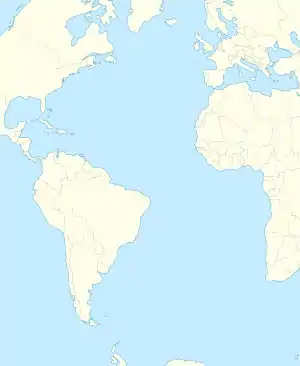Muir Seamount
Muir Seamount is a seamount (underwater volcano), located at 33°43.20′N 62°29.40′W.[1] It is located in the Bermuda rise, a seismically active region, and was the site of an earthquake on 24 March 1978.[2]
| Muir Seamount | |
|---|---|
 Bathymetry of Muir Seamount | |
 Bathymetric map | |
| Location | |
| Location | Mid-Atlantic, north of Bermuda |
| Coordinates | 33°43.20′N 62°29.40′W[1] |
| Geology | |
| Type | Seamount (Submarine volcano) |
| Volcanic arc/chain | Bermuda rise |
Fourteen core samples of up to 125,000 years of age were collected off of Muir Seamount, ranging in depth to more than 3,000 m (9,843 ft). These samples were used to analyse the weight percentage of carbonate over time on the ocean floor, which in turn would provide clues to the oceanic environment over time. Overall concentrations were most stable at 4,650 m (15,256 ft) of depth. This was interpreted as indicating an increase in flow form colder waters of Antarctic flow, and the stagnation of the North American flows.[3] A total of 8 core samples have been gathered, with ages ranging from Pliocene to Late Cretaceous. No radiometric dates are available for the seamount, but it may of Early Cretaceous time.[4]
Over 150 invertebrates have been collected in total from Bear, Manning, and Muir seamounts. Ophiuroids and goose barnacles are the most abundant animal found on the seamount, as is Asteroshchema sp., a basket star. Paragorgia have also been observed. Genetic tests on the specimens collected indicated that Muir Seamount is the most genetically isolated of the four.[5]
References
- "Seamount Catalog: Muir Seamount". Seamounts database. EarthRef, a National Science Foundation project. Retrieved 16 January 2013.
- Nishenko, S. P.; Kafka, A.L. (1982). "Earthquake focal mechanisms and the intraplate setting of the Bermuda rise". Journal of Geophysical Research. 87 (B5): 3929–3942. Bibcode:1982JGR....87.3929N. doi:10.1029/JB087iB05p03929. ISSN 0148-0227.
- L. Balsam, William (September 1983). "Carbonate dissolution on the Muir Seamount (western North Atlantic); interglacial/glacial changes". Journal of Sedimentary Research. SEPM [Society for Sedimentary Geology]. 53 (3): 719–731. doi:10.1306/212F82AB-2B24-11D7-8648000102C1865D.
- Gillain R. Foulger and Donna M. Jurdy, ed. (2007). Plates, plumes, and planetary processes. Special Paper 430. Geological Society of America. p. 562. ISBN 978-0-8137-2430-0.
- Walter Cho and Dr. Timothy M. Shank. "Molecular Systematics and Population Connectivity of Seamount Faunal Populations on the New England and Corner Rise Seamounts". Woods Hole Oceanographic Institution (WHOI). Retrieved 16 January 2013.